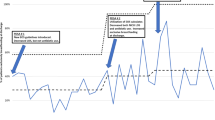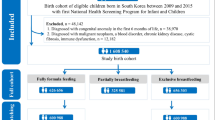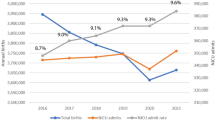Abstract
Objective:
We hypothesized that neonatal intensive care unit (NICU) admission reduces breastfeeding in a recent population of US infants, adjusting for confounding factors.
Study Design:
Using pregnancy risk assessment monitoring system data from 27 states for the years 2000 to 2003, we determined the relationship between breastfeeding and gestational age (GA) stratified by NICU status. We fitted a proportional odds model for breastfeeding duration as a function of NICU status adjusted for other covariates. SAS 9.1.3 and SUDAAN 9.0 were used for the weighted analyses.
Result:
In total 138 359 surveys, including 29 940 NICU-admitted infants, were analyzed. A total of 73% of mothers of nonadmitted infants initiated breastfeeding vs 70% of mothers of NICU-admitted infants. Mothers of GA <38 weeks NICU-admitted infants were 34% more likely to initiate breastfeeding and 21% more likely to breastfeed for 4 weeks than were mothers of nonadmitted preterm infants (P<0.001). However, mothers of term NICU-admitted infants were less likely to initiate and continue breastfeeding to 4 weeks than were mothers of term nonadmitted infants (P<0.001). Adjusting for GA, race, maternal age, maternal education, mode of delivery and Medicaid status, NICU admission was associated with increasing duration of breastfeeding (OR 1.10, CI 1.03, 1.17). Compared with mothers of term infants, mothers of <32-week infants were 40% more likely to continue breastfeeding for 4 weeks, mothers of 32 to 34 week infants were 13% less likely to continue and mothers of 35–37 week infants were 22% less likely to continue for at least 4 weeks (P<0.001).
Conclusion:
NICU admission is now a positive influence on breastfeeding continuation, improving the overall likelihood by 10%. Mothers of preterm NICU-admitted infants were more likely than mothers of nonadmitted infants to continue breastfeeding for 4 weeks, while mothers of term NICU-admitted infants were less likely to continue. Breastfeeding support should be enhanced for term and late preterm infants.
This is a preview of subscription content, access via your institution
Access options
Subscribe to this journal
Receive 12 print issues and online access
$259.00 per year
only $21.58 per issue
Buy this article
- Purchase on Springer Link
- Instant access to full article PDF
Prices may be subject to local taxes which are calculated during checkout
Similar content being viewed by others
References
Angelsen NK, Vik T, Jacobsen G, Bakketeig LS . Breast feeding and cognitive development at age 1 and 5 years. Arch Dis Child 2001; 85 (3): 183–188.
Daniels MC, Adair LS . Breast-feeding influences cognitive development in Filipino children. J Nutr 2005; 135 (11): 2589–2595.
Arenz S, Rückerl R, Koletzko B, von Kries R . Breast-feeding and childhood obesity—a systematic review. Int J Obesity 2004; 28 (10): 1247–1256.
Harder T, Bergmann R, Kallischnigg G, Plagemann A . Duration of breastfeeding and risk of overweight: a meta-analysis. Am J Epidemiol 2005; 162 (5): 397–403.
Gdalevich M, Mimouni D, David M, Mimouni M . Breast-feeding and the onset of atopic dermatitis in childhood: a systematic review and meta-analysis of prospective studies. J Am Acad Dermatol 2001; 45 (4): 520–527.
Oddy W, Wendy H . A review of the effects of breastfeeding on respiratory infections, atopy, and childhood asthma. J Asthma 2004; 41 (6): 605–621.
Owen W, Odoki JA, Gilg DG, Cook CG . Infant feeding and blood cholesterol: a study in adolescents and a systematic review. Pediatrics 2002; 110 (3): 597–608.
Owen W, Gilg DG, Cook CG, Owen PH, Whincup JA . Effect of breast feeding in infancy on blood pressure in later life: systematic review and meta-analysis. BMJ 2003; 327 (7425): 1189–1195.
Lucas AA, Cole TJ . Breast milk and neonatal necrotising enterocolitis. Lancet 1990; 336 (8730): 1519–1523.
Schanler RJ, Shulman RJ, Lau C, Smith EO, Heitkemper MM . Feeding strategies for premature infants: randomized trial of gastrointestinal priming and tube-feeding method. (see comment). Pediatrics 1999; 103 (2): 434–439.
Hylander S, Dhanireddy MA, Strobino RR . Human milk feedings and infection among very low birth weight infants. Pediatrics 1998; 102 (3): E38.
Gartner LM, Morton J, Lawrence RA, Naylor AJ, O’Hare D, Schanler RJ et al. Breastfeeding and the use of human milk. Pediatrics 2005; 115 (2): 496–506.
Healthy People 2010. Objectives for Improving Health: Breastfeeding. Available at http://www.healthypeople.gov/Document/HTML/Volume2/16MICH.htm_Toc494699668accessed 07 August 2007.
March of Dimes PeriStats: Your online source for perinatal statistics. Available at http://www.marchofdimes.com/peristats/accessed 25 January 2008.
Ahluwalia IB, Morrow B, Hsia J, Grummer-Strawn LM . Who is breast-feeding? Recent trends from the pregnancy risk assessment and monitoring system. J Pediatr 2003; 142 (5): 486–491.
Pregnancy Risk Assessment Monitoring System (PRAMS): Methodology. Available at http://www.cdc.gov/prams/methodology.htm, accessed 25 January 2008.
Ahluwalia IB, Morrow B, Hsia J . Why do women stop breastfeeding? Findings from the pregnancy risk assessment and monitoring system. Pediatrics 2005; 116 (6): 1408–1412.
Racial and socioeconomic disparities in breastfeeding—United States 2004. MMWR Morb Mortal Wkly Rep 2006; 55 (12): 335–339.
Ryan AS, Wenjun Z, Acosta A . Breastfeeding continues to increase into the new millennium. Pediatrics 2002; 110 (6): 1103–1109.
Callen J, Pinelli J . A review of the literature examining the benefits and challenges, incidence and duration, and barriers to breastfeeding in preterm infants. Adv Neonatal Care 2005; 5 (2): 72–88; quiz 89–92.
Hill PD, Ledbetter RJ, Kavanaugh KL . Breastfeeding patterns of low-birth-weight infants after hospital discharge. J Obstet Gynecol Neonatal Nurs 1997; 26 (2): 189–197.
Britton C, McCormick FM, Renfrew MJ, Wade A, King SE . Support for breastfeeding mothers. Cochrane Database Syst Rev 2007; (1): CD001141.
Castrucci BC, Hoover KL, Lim S, Maus KC . Availability of lactation counseling services influences breastfeeding among infants admitted to neonatal intensive care units. Am J Health Promot 2007; 21 (5): 410–415.
Sisk PM, Lovelady CA, Dillard RG, Gruber KJ . Lactation counseling for mothers of very low birth weight infants: effect on maternal anxiety and infant intake of human milk. Pediatrics 2006; 117 (1): e67–e75.
Escobar GJ, Clark RH, Greene JD . Short-term outcomes of infants born at 35 and 36 weeks gestation: we need to ask more questions. Semin Perinatol 2006; 30 (1): 28–33.
Shapiro-Mendoza CK, Tomashek KM, Kotelchuck M, Barfield W, Weiss J, Evans S . Risk factors for neonatal morbidity and mortality among ‘healthy,’ late preterm newborns. Semin Perinatol 2006; 30 (2): 54–60.
Tomashek KM, Shapiro-Mendoza CK, Weiss J, Kotelchuck M, Barfield W, Evans S et al. Early discharge among late preterm and term newborns and risk of neonatal morbidity. Semin Perinatol 2006; 30 (2): 61–68.
Wang ML, Dorer DJ, Fleming MP, Catlin EA . Clinical outcomes of near-term infants. Pediatrics 2004; 114 (2): 372–376.
Chen DC, Nommsen-Rivers L, Dewey KG, Lonnerdal B . Stress during labor and delivery and early lactation performance. Am J Clin Nutr 1998; 68 (2): 335–344.
Cregan MD, de Mello TR, Hartmann PE . Pre-term delivery and breast expression: consequences for initiating lactation. Adv Exp Med Biol 2000; 478: 427–428.
Gewolb IH, Vice FL . Maturational changes in the rhythms, patterning, and coordination of respiration and swallow during feeding in preterm and term infants. Dev Med Child Neurol 2006; 48 (7): 589–594.
Medoff-Cooper B, McGrath JM, Shults J . Feeding patterns of full-term and preterm infants at forty weeks postconceptional age. J Dev Behav Pediatr 2002; 23 (4): 231–236.
Meier PP, Engstrom JL, Mangurten HH, Estrada E, Zimmerman B, Kopparthi R . Breastfeeding support services in the neonatal intensive-care unit. J Obstet Gynecol Neonatal Nurs 1993; 22 (4): 338–347.
Meier PP, Furman LM, Degenhardt M . Increased lactation risk for late preterm infants and mothers: evidence and management strategies to protect breastfeeding. J Midwifery Womens Health 2007; 52 (6): 579–587.
Hurst M, Schanler RJ, Myatt AA . Growth and development of a hospital-based lactation program and mother's own milk bank. J Obstet Gynecol Neonatal Nurs 1998; 27 (5): 503–510.
RTI International. PRAMS Version 4 Questionnaire Evaluation. 2007. RTI International: Research Triangle, NC unpublished data, accessed February 2008.
Acknowledgements
The PRAMS Working Group: Alabama—Albert Woolbright, PhD; Alaska—Kathy Perham-Hester, MS, MPH; Arkansas—Gina Redford, MAP; Colorado—Alyson Shupe, PhD; Florida—Helen Marshall; Georgia—Carol Hoban, MS, MPH; Hawaii—Limin Song, MPH, CHES; Illinois—Theresa Sandidge, MA; Louisiana—Joan Wightkin; Maine—Kim Haggan; Maryland—Diana Cheng, MD; Michigan—Yasmina Bouraoui, MPH; Minnesota—Jan Jernell; Mississippi—Linda Pendleton, LMSW; Montana—JoAnn Dotson; Nebraska—Jennifer Severe-Oforah; New Jersey—Lakota Kruse, MD; New Mexico—Ssu Weng, MD, MPH; New York State—Anne Radigan-Garcia; New York City—Candace Mulready, MPH; North Carolina—Paul Buescher, PhD; North Dakota—Sandra Anseth, RN; Ohio—Amy Davis; Oklahoma—Dick Lorenz; Oregon—Ken Rosenberg, MD, MPH; Rhode Island—Sam Viner-Brown; South Carolina—Jim Ferguson, DrPH; Texas—Tanya J. Guthrie, PhD; Utah—Laurie Baksh; Vermont—Peggy Brozicevic; Washington—Linda Lohdefinck; West Virginia—Melissa Baker, MA; CDC PRAMS Team, Applied Sciences Branch, Division of Reproductive Health. The authors have no commercial, proprietary or financial conflicts to disclose.
Author information
Authors and Affiliations
Corresponding author
Rights and permissions
About this article
Cite this article
Colaizy, T., Morriss, F. Positive effect of NICU admission on breastfeeding of preterm US infants in 2000 to 2003. J Perinatol 28, 505–510 (2008). https://doi.org/10.1038/jp.2008.32
Received:
Revised:
Accepted:
Published:
Issue Date:
DOI: https://doi.org/10.1038/jp.2008.32
Keywords
This article is cited by
-
Breastfeeding initiation, duration, and experiences of mothers of late preterm twins: a mixed-methods study
International Breastfeeding Journal (2022)
-
The management of late preterm infants: effects of rooming-in assistance versus direct admission to neonatal care units
European Journal of Pediatrics (2022)
-
Strategies to increase the use of mother’s own milk for infants at risk of necrotizing enterocolitis
Pediatric Research (2020)
-
Racial/ethnic differences in necrotizing enterocolitis incidence and outcomes in premature very low birth weight infants
Journal of Perinatology (2018)
-
Impact of NICU admission on Colorado-born late preterm infants: breastfeeding initiation, continuation and in-hospital breastfeeding practices
Journal of Perinatology (2018)



